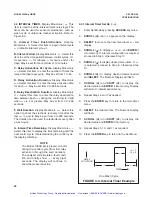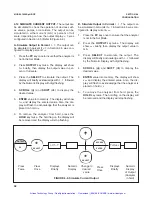
38
7.1 THEORY OF OPERATION (pH).
This section is a
general description of how the Model 1054B pH oper-
ates. This section is for those users who desire a
greater understanding of the analyzer's operation.
The measurement of the process’ pH is accomplished
by the use of two electrodes within the sensor. The
glass electrode is pH sensitive and generates a high
impedance millivolt potential directly proportional to
the process pH. The reference electrode is a second
half cell that completes the circuit via a liquid junction.
The high impedance signal is preamplified at the sen-
sor to allow a stable noise-free signal that can be
transmitted up to 1,000 feet.
The Model 1054B pH also measures the process tem-
perature via a platinum 100 ohm RTD imbedded in the
sensor. Advanced circuitry is used to eliminate errors
due to changes in cable resistance. The analyzer uses
this temperature measurement to compensate for
changes in the sensor millivolt output caused by tem-
perature change.
7.2 THEORY OF OPERATION (ORP).
This section is
a general description of how the 1054B ORP oper-
ates. The selected sensor generates a voltage
dependent on the oxidation reduction potential (ORP)
measured in the process. This voltage signal is fed
into a high-impedance amplifier (preamp) prior to
transmission to the Model 1054A ORP. The high
impedance and low voltage of the sensor make a pre-
amplifier necessary for a reliable ORP signal to reach
the transmitter.
The analog signal from the preamp is digitized by the
signal conditioning circuit, becoming a digital signal
(proportional to the ORP) that can be read by the
CPU. This digital signal is then used to calculate an
ORP value.
The CPU also contains an on board electrically erasa-
ble and programmable read-only memory
(EEPROM) which maintains memory during power
outages. The CPU is supported by read-only memory
(ROM) containing the operating instructions for the
CPU.
The CPU controls the operation of the liquid crystal
display, Alarm 1, Alarm 2 and also creates a pulse
width modulated (PWM) signal. The PWM signal is
converted by the isolated output circuit (located on the
power board) to a selectable current output (0 to
20mA or 4 to 20mA).
The keyboard is a matrix of on/off switch positions that
the CPU scans periodically to determine if a button is
depressed. The CPU reacts when a key is depressed
to display a different parameter or to modify its func-
tion in some manner. Even though the ORP measure-
ment is not temperature sensitive, process
temperature is accurately measured at the ORP sen-
sor through the use of a PT-100 RTD and is displayed
by the 1054A ORP over the range of -15 to135°C. For
a more accurate temperature reading the analyzer
temperature indication may be standardized to the
process temperature by pressing the
TEMP
key and
adjusting the indicated value.
MODEL 1054B pH/ORP
SECTION 7.0
THEORY OF OPERATION
SECTION 7.0
THEORY OF OPERATION
Artisan Technology Group - Quality Instrumentation ... Guaranteed | (888) 88-SOURCE | www.artisantg.com










































